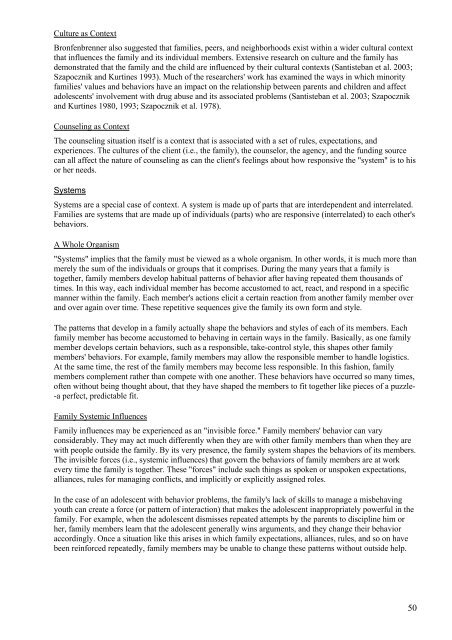FAMILY THERAPY - DEAN AMORY
This is the new, extended and improved version of “An Introduction to Family Therapy”, your reference guide containing detailed information about all important facets of family therapy: schools and methods, strategies used, structure and content of family therapy sessions, stages, basic techniques, influential people, history of family therapy,… Since I feel many people will benefit and appreciate being allowed easy access to this kind of information ordered in short, easily accessible chapters, I decided to make this compilation work - based on information freely available in the public domain -, available for free to everybody as a download file. ----//---- The cover illustration is from Zirta from Mexico: www.zirta.net - email address: beatriz@zirta.net
This is the new, extended and improved version of “An Introduction to Family Therapy”, your reference guide containing detailed information about all important facets of family therapy: schools and methods, strategies used, structure and content of family therapy sessions, stages, basic techniques, influential people, history of family therapy,… Since I feel many people will benefit and appreciate being allowed easy access to this kind of information ordered in short, easily accessible chapters, I decided to make this compilation work - based on information freely available in the public domain -, available for free to everybody as a download file.
----//----
The cover illustration is from Zirta from Mexico: www.zirta.net - email address: beatriz@zirta.net
Create successful ePaper yourself
Turn your PDF publications into a flip-book with our unique Google optimized e-Paper software.
Culture as Context<br />
Bronfenbrenner also suggested that families, peers, and neighborhoods exist within a wider cultural context<br />
that influences the family and its individual members. Extensive research on culture and the family has<br />
demonstrated that the family and the child are influenced by their cultural contexts (Santisteban et al. 2003;<br />
Szapocznik and Kurtines 1993). Much of the researchers' work has examined the ways in which minority<br />
families' values and behaviors have an impact on the relationship between parents and children and affect<br />
adolescents' involvement with drug abuse and its associated problems (Santisteban et al. 2003; Szapocznik<br />
and Kurtines 1980, 1993; Szapocznik et al. 1978).<br />
Counseling as Context<br />
The counseling situation itself is a context that is associated with a set of rules, expectations, and<br />
experiences. The cultures of the client (i.e., the family), the counselor, the agency, and the funding source<br />
can all affect the nature of counseling as can the client's feelings about how responsive the "system" is to his<br />
or her needs.<br />
Systems<br />
Systems are a special case of context. A system is made up of parts that are interdependent and interrelated.<br />
Families are systems that are made up of individuals (parts) who are responsive (interrelated) to each other's<br />
behaviors.<br />
A Whole Organism<br />
"Systems" implies that the family must be viewed as a whole organism. In other words, it is much more than<br />
merely the sum of the individuals or groups that it comprises. During the many years that a family is<br />
together, family members develop habitual patterns of behavior after having repeated them thousands of<br />
times. In this way, each individual member has become accustomed to act, react, and respond in a specific<br />
manner within the family. Each member's actions elicit a certain reaction from another family member over<br />
and over again over time. These repetitive sequences give the family its own form and style.<br />
The patterns that develop in a family actually shape the behaviors and styles of each of its members. Each<br />
family member has become accustomed to behaving in certain ways in the family. Basically, as one family<br />
member develops certain behaviors, such as a responsible, take-control style, this shapes other family<br />
members' behaviors. For example, family members may allow the responsible member to handle logistics.<br />
At the same time, the rest of the family members may become less responsible. In this fashion, family<br />
members complement rather than compete with one another. These behaviors have occurred so many times,<br />
often without being thought about, that they have shaped the members to fit together like pieces of a puzzle-<br />
-a perfect, predictable fit.<br />
Family Systemic Influences<br />
Family influences may be experienced as an "invisible force." Family members' behavior can vary<br />
considerably. They may act much differently when they are with other family members than when they are<br />
with people outside the family. By its very presence, the family system shapes the behaviors of its members.<br />
The invisible forces (i.e., systemic influences) that govern the behaviors of family members are at work<br />
every time the family is together. These "forces" include such things as spoken or unspoken expectations,<br />
alliances, rules for managing conflicts, and implicitly or explicitly assigned roles.<br />
In the case of an adolescent with behavior problems, the family's lack of skills to manage a misbehaving<br />
youth can create a force (or pattern of interaction) that makes the adolescent inappropriately powerful in the<br />
family. For example, when the adolescent dismisses repeated attempts by the parents to discipline him or<br />
her, family members learn that the adolescent generally wins arguments, and they change their behavior<br />
accordingly. Once a situation like this arises in which family expectations, alliances, rules, and so on have<br />
been reinforced repeatedly, family members may be unable to change these patterns without outside help.<br />
50


















